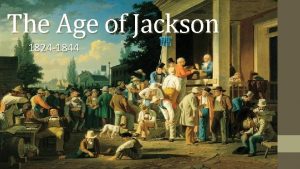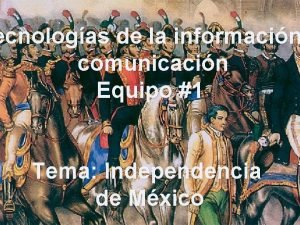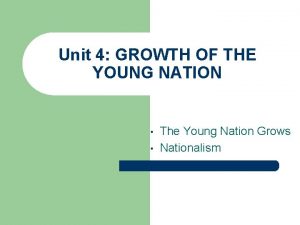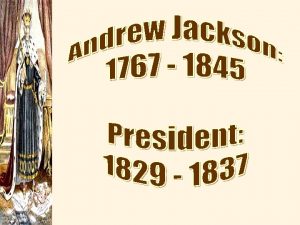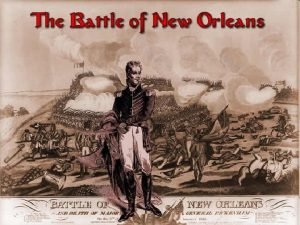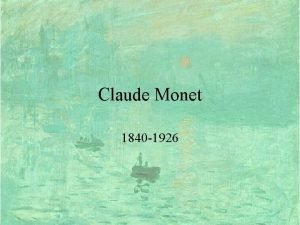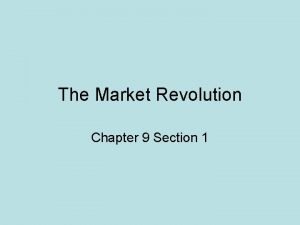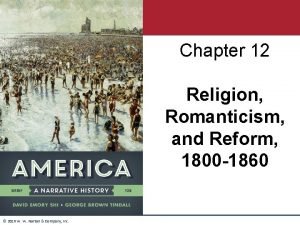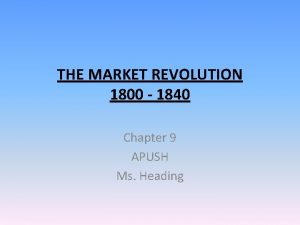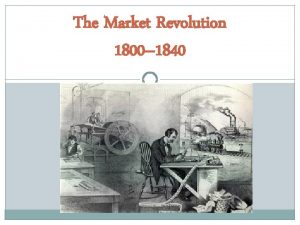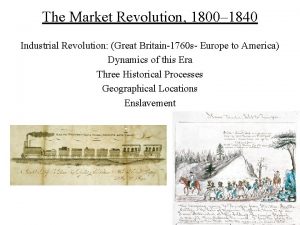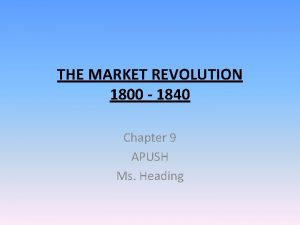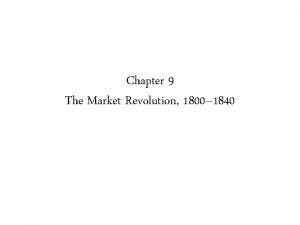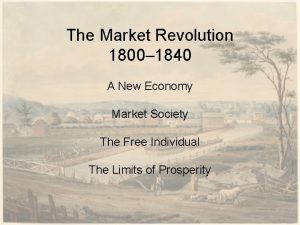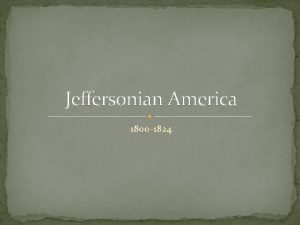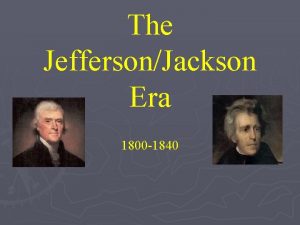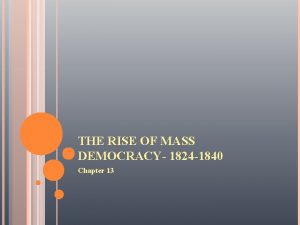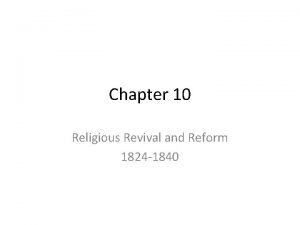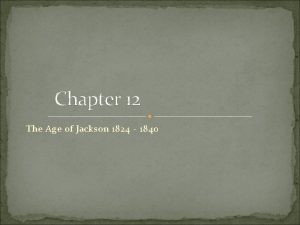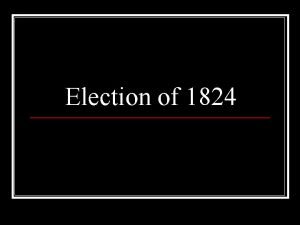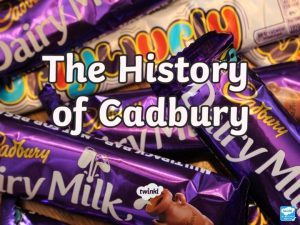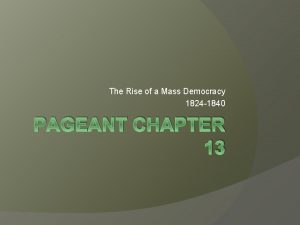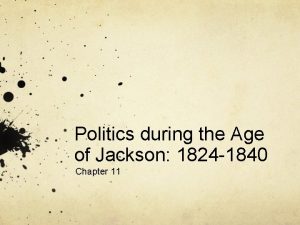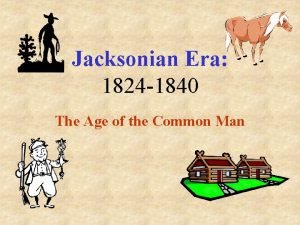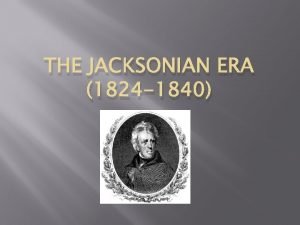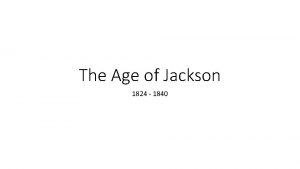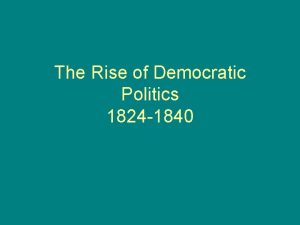Chapter 9 The Market Revolution 1800 1840 1824





























































- Slides: 61

Chapter 9: The Market Revolution, 1800 - 1840

• 1824 – the Marquis de Lafayette visited the United States, went on a 13 -month tour of the nation, a triumphant Jubilee of Liberty • nation’s population had tripled to nearly 12 million • land area had more than doubled and its political institutions had thrived • demonstrated how much the nation had changed • the 13 states of 1784 had grown to 24, and Lafayette visited every one • traveled up the Mississippi and Ohio Rivers by steamboat • steamboats were a recent innovation that helped to bring economic development to the trans. Appalachian West • crossed upstate New York via the Erie Canal – the world’s longest man-made waterway (at that time)

• likenesses of the goddess of Liberty became even more common in the United States • celebration of freedom could be found in sermons, newspaper editorials, and political pronouncements in every region of the country • Democracy in America, Alexis de Tocqueville a French historian and politician wrote of the “holy cult of freedom” • Americans’ understandings of freedom were changing • three historical processes unleashed by the Revolution accelerated after the War of 1812: the spread of market relations, the westward movement of the population, and the rise of a vigorous political democracy • helped to reshape the idea of freedom • economic opportunity, physical mobility, and participation in a vibrantly democratic political system

• American freedom also continued to be shaped by the presence of slavery • slavery was moving westward with the young republic • steamboats and canals – also facilitated the growth of slave-based cotton plantations in the South • slavery drew a strict racial boundary around American democracy, making voting, office-holding, and participation in the public sphere privileges for whites alone • the coexistence of liberty and slavery, and their simultaneous expansion, remained the central contradiction of American life

A New Economy

• economic transformation – market revolution • catalyst was a series of innovations in transportation and communication • represented an acceleration of developments already under way in the colonial era • colonists had been drawn into Britain’s commercial empire • as Americans moved across the Appalachian Mountains, and into the interior regions of the states along the Atlantic coast, they found themselves more and more isolated from markets • 1800 – American farm families produced most of what they needed at home (clothing and farm implements) • things they could not make themselves, they obtained by bartering with their neighbors, or purchasing from local stores and from rural craftsmen like blacksmiths and shoemakers

• early life of Abraham Lincoln – essentially his family was self-sufficient • hunted game for much of their food and sewed most of their clothing at home • relied little on cash • as an adult – Lincoln embraced the market revolution • as a member of the Illinois legislature in the 1830 s – he eagerly promoted the improvement of rivers to facilitate access to markets

Roads and Steamboats • steamboat, canal, railroad, and telegraphs • opened new land to settlement, lowered transportation costs, and made it far easier for economic enterprises to sell their products • linked farmers to national and world markets – made them major consumers of manufactured goods • first advance in overland transportation – toll roads, or “turnpikes” – by localities, states, and private companies • 1806 – Congress authorized the construction of the paved National Road from Cumberland, Maryland to the Old Northwest

• maintenance costs were higher than expected and many towns built “shunpikes” – short detours that enabled residents to avoid tollgates, most private toll roads never turned a profit • horse-drawn wagons remained an inefficient mode of getting goods to market except over short distances • improved water transportation most dramatically increased the speed and lowered the expense of commerce • Robert Fulton – Fulton’s ship the Clermont navigated the Hudson River from New York City to Albany – proved the steamboat’s technological and commercial feasibility • made possible upstream commerce – travel against the current

The Erie Canal • completion in 1825 of the 363 -mile Erie Canal, allowed goods to flow between the Great Lakes and New York City • canal attracted an influx of farmers migrating from New England, giving birth to cities • New York governor De. Witt Clinton – oversaw the construction of the statefinanced canal • canal gave New York City primacy over competing ports in access to trade with the Old Northwest • typified the developing transportation infrastructure • federal government generally under the control of political leaders was hostile to federal funding for internal improvements, so the burden fell on the states

• Erie Canal – set off a scramble among other states to match New York’s success • canals – created a network linking the Atlantic states with the Ohio and Mississippi Valleys and drastically reduced the cost of transportation

Railroads and Telegraph • canals connected existing waterways • railroad opened vast new areas of the American interior to settlement • stimulating the mining of coal for fuel and the manufacture of iron for locomotives and rails • Baltimore and Ohio – the nation’s first commercial railroad

• telegraph made possible instantaneous communication throughout the nation • invented during the 1830 s by Samuel F. B. Morse • using Morse code, messages could be sent over electric wires, each letter and number represented by its own pattern of electrical pulses • initially, the telegraph was a service for businesses – especially newspapers • helped speed the flow of information and brought uniformity to prices throughout the country

The Rise of the West • improvements in transportation and communication made possible the rise of the West as a powerful, self-conscious region of the new nation • most of this migration took place after the end of the War of 1812 • following the end of the war in 1815 – six new states entered the Union (Indiana, Illinois, Missouri, Alabama, Mississippi, and Maine) • few Americans moved west as lone pioneers – traveled in groups and cooperated with each other to clear land, build houses, and barns, and establish communities • one stream of migration flowed out of the South – creating the new Cotton Kingdom of Alabama, Mississippi, Louisiana, and Arkansas • families from the Upper South crossed into southern Ohio, Indiana, and Illinois • third population stream moved from New England across New York to the Upper Northwest – northern Ohio, Indiana, and Illinois, and Michigan and Wisconsin

• some western migrants became “squatters” – setting up farms on unoccupied land without a clear legal title • if they purchased land it came from the federal government – at the price of $1. 25 an acre payable in cash after 1820 • also purchased from land speculators on longterm credit • by 1840 the Old Northwest and Old Southwest – had entered the Union • West – became the home of regional cultures

• as population moved west, the nation’s borders expanded • national boundaries made little difference • Florida, and later in Texas and Oregon, American settlers rushed in to claim land under the jurisdiction of foreign countries confident that American sovereignty would soon follow • Florida – fell into American hands despite the resistance of local Indians and Spain’s rejection of American offers to buy the area • 1810 – American residents of West Florida rebelled and seized Baton Rouge • United States soon annexed the area

• drive for the acquisition of East Florida was spurred by Georgia and Alabama planters – wished to eliminate a refuge for fugitive slaves and hostile Seminole Indians • Andrew Jackson led troops into the area in 1818 • created an international crisis by executing two British traders and a number of Indian chiefs • Spain – aware that it could not defend the territory, sold it to the United States in the Adams-Onís Treaty of 1819 – negotiated by John Quincy Adams • Andrew Jackson, Henry Clay, and many other statesmen had been born in states along the Atlantic coast, but made their mark in politics after moving west

The Cotton Kingdom • the most dynamic feature of the American economy in the first 30 years of the 19 th century was the rise of the Cotton Kingdom • early industrial revolution – centered on factories producing cotton textiles with waterpowered spinning and weaving machinery • generated an immense demand for cotton • was particularly suited to growing in the Deep South, because of its climate and soil fertility • laborious task of removing the seeds from the plant itself was changed by the invention of the cotton gin by Eli Whitney in 1793 • a Yale graduate, he was working in Georgia as a private tutor • consisted of rollers and brushes, that quickly separated the seed from the cotton • made possible the growing and selling of cotton on a large scale

• Whitney’s invention – revolutionized American slavery • institution that many Americans had expected to die out because its major crop was exhausting the soil (tobacco) • cotton plantations spread into the South Carolina upcountry – major reason why the state reopened the African slave trade between 1803 and 1808 • after the War of 1812, government moved to consolidate American control over the Deep South, forcing defeated Indians to cede land, encouraging white settlement, and acquiring Florida • American sovereignty – came the expansion of slavery – planters monopolized the most fertile land – poorer farmers were generally confined to less productive and less accessible areas in the “hill country” • Congress prohibited the Atlantic slave trade in 1808 – massive trade in slaves developed within the United States – supplying the labor force required by the new Cotton Kingdom

The Unfree Westward Movement • around 1 million slaves were shifted from the older slave states to the Deep South between 1800 and 1860 • traveled with their owners – majority were transported by slave traders to be sold at auction for work in the cotton fields • slave trading became a well-organized business • slave coffles – groups chained to one another on forced marches • westward movement meant to African-Americans the destruction of family ties, the breakup of longstanding communities, and receding opportunities for liberty • as the southern economy expanded westward, it was cotton produced on slave plantations, not grain grown by sturdy yeoman, that became the linchpin of southern development and by far the most important export of the empire of liberty

Market Society

• cotton was produced solely for sale in national and international markets, the South was in some ways the most commercially oriented region of the United States • South’s expansion westward simply reproduced the same agrarian, slave-based social order of the older states • remained overwhelmingly rural • transportation and banking systems remained adjuncts of the plantation economy, geared largely to transporting cotton and other staple crops to market and financing the purchase of land slaves

Commercial Farmers • market revolution and westward expansion started a transformation of the region into an integrated economy of commercial farms and manufacturing cities • initial pioneer stage of settlement reinforced the farmer’s selfsufficiency • Old Northwest – became a more settled society, bound by a web of transportation and credit to eastern centers of commerce and banking, farmers found themselves drawn into the new market economy • increasingly concentrated on growing crops and raising livestock for sale, while purchasing at stores goods previously produced at home

• western farmers found in the growing cities of the East a market for their produce and a source of credit • steel plow – invented by John Deere, made possible the rapid subduing of the western prairies • mechanized reaper – invented by Cyrus Mc. Cormick, horse-drawn machine that greatly increased the amount of wheat a farmer could harvest (produced in large quantities soon afterward) • unlike cotton, the bulk of the crop was consumed within the country • eastern farmers increasingly concentrated on producing dairy products, fruits, and vegetables for nearby urban centers

The Growth of Cities • Cincinnati and St. Louis – stood at the crossroads of inter-regional trade experienced extraordinary growth • greatest of all the western cities was Chicago • urban centers witnessed dramatic changes due to the market revolution • urban merchants, bankers, and master craftsmen took advantage of the economic opportunities created by the expanding market among commercial farmers • increased production and reduced labor costs • traditionally, skilled artisans had manufactured goods at home, controlled the pace and intensity of their own labor • entrepreneurs – gathered artisans into large workshops in order to oversee their work and subdivide their tasks • labor process broken down into numerous steps requiring far less skill and training • subjected to constant supervision by their employers and relentless pressure for greater output and lower wages

The Factory System • textiles – factory superseded traditional craft production altogether • large groups of workers under central supervision, replaced hand tools with power-driven machinery • Samuel Slater – established America’s first factory • British law – made it illegal to export the plans for industrial machinery, Slater, a skilled mechanic, built from memory a power-driven spinning jenny, one of the key inventions of the early industrial revolution

• produced yarn – was then sent to traditional hand-loom weavers and farm families to be woven into cloth • “outwork” system – rural men and women earned money by taking in jobs from factories (early industrialization) • shoe production – various parts of the shoe were produced in factories, then stitched together in nearby homes, returned to the factories for finishing • eventually the entire manufacturing process in textiles, shoes, and many other products was brought under a single factory roof

• cutoff of British imports – stimulated the establishment of the first large-scale American factory utilizing power looms for weaving cotton cloth • Lowell – created an entirely new factory town; built a group of modern textile factories that brought together all phases of production from the spinning of thread to the weaving and finishing of cloth • located along the “fall line” – where waterfalls and river rapids could be harnessed to provide power for spinning and weaving machinery • 1840 s – steam power made it possible for factory owners to locate in towns like New Bedford nearer the coast and in large cities • 1850 – manufacturers produced in factories not only textiles, but also a wide variety of goods, including tools, firearms, shoes, clocks, ironware, and agricultural machinery

• “American system of manufactures” – relied on the mass production of interchangeable parts that could be rapidly assembled into standardized finished products • first perfected in the manufacture of clocks by Eli Terry and in smallarms production by Eli Whitney • wide dispersion of mechanical skills throughout northern society • early industrial revolution was largely confined to New England • lacking a strong internal market – South lagged in factory production


The Industrial Worker • farm life continued to be regulated by the rhythms of the seasons • in cities – clocks became part of daily life; work time and leisure time came to be clearly marked off from one another • as the market revolution accelerated, work in factories, workshops, and even for servants in Americans’ homes took place for a specified number of hours per day • colonial America – artisan’s pay was known as his “price’ • 19 th century – pay increasingly became a “wage, ” paid according to an hourly or daily rate • increasing reliance on railroads – operated according to fixed schedules, also made Americans more conscious of arranging their lives according to “clock time” • employers turned to those who lacked other ways of earning a living

The “Mill Girls” • some factories employed entire families, the early New England textile mills relied largely on female and child labor • Lowell – young unmarried women from Yankee farm families dominated • Lowell owners set up boarding houses with strict rules regulating personal behavior • lecture halls and churches to occupy the women’s free time • valued the opportunity to earn money independently at a time when few other jobs were open to women • did not become a permanent class of factory workers • typically remained in the factories for only a few years, after which they left to return home, marry, or move west • shortage of industrial labor continued – easing only when large-scale immigration began in the 1840 s and 1850 s

The Growth of Immigration • economic expansion fueled a demand for labor and increased immigration from abroad • majority from Ireland Germany – 90% headed for the northern states, where job opportunities were most abundant and they would not have to compete with slave labor • immigrants were virtually unknown in the slave states • became a visible presence in both urban and rural areas • numerous factors inspired this massive flow • Europe – the modernization of agriculture and the industrial revolution disrupted centuries-old patterns of life, pushing peasants off the land eliminating the jobs of traditional craft workers • oceangoing steamship and the railroad made longdistance travel more practical • Cunard Line – regular sailing with inexpensive fares • frequently – a male family member emigrated first; he would later send back money for the rest of the family to follow

Irish and German Newcomers • America’s political and religious freedoms attracted Europeans who chafed under the continent’s repressive governments and rigid social hierarchies • “here everyone is a free agent” • largest number of immigrants were refugees from disaster – Irish men and women fleeing the Great Famine of 1845 -1851 (a blight that destroyed the potato crop on which the island’s diet rested) • lacking industrial skills and capital, these impoverished agricultural laborers and small farmers ended up filling the low-wage unskilled jobs native-born Americans sought to avoid • male Irish immigrants built America’s railroads, dug canals, and worked as common laborers, servants, longshoremen, and factory operatives

• Irish women went to work as servants in the homes of nativeborn Americans • some preferred factory work to domestic service • servants were on call at any time • Lowell textile mills had largely replaced Yankee farm women with immigrant Irish families • congregated in overcrowded urban ghettos notorious for poverty, crime, and disease

• second-largest group of immigrants – Germans • had a larger number of skilled craftsmen and settled in tightly knit neighborhoods • many were able to move to the West and became craftsmen, shopkeepers, and farmers • “German triangle” – Cincinnati, St. Louis, and Milwaukee • vibrant German-language culture – own schools, newspapers, associations, and churches – developed wherever large numbers of Germans settled • 40, 000 Scandinavians also emigrated • settled on farms in the Old Northwest • failure of the Chartist movement inspired many English workers to emigrate to the United States

The Rise of Nativism • immigrants from England – were easily absorbed, but those from Ireland encountered intense hostility • Roman Catholics – faced discrimination in a largely Protestant society in which the tradition of “anti-popery” still ran deep • Archbishop John Hughes of New York City – pressed Catholic parents to send their children to an expanding network of parochial schools, sought government funding to pay for them • sought to win converts from Protestantism

• many Protestants found such activities alarming • Lyman Beecher – a prominent Presbyterian minister warned that Catholics were seeking to dominate the American West – where the future of Christianity in the world would be worked out • sermon inspired a mob to burn a Catholic convent in the city • the idea of the United States as a refuge for those seeking economic opportunity as an escape from oppression has always coexisted with suspicion of and hostility to foreign newcomers

• those who feared the impact of immigration on American political and social life were called “nativists” • blamed immigrants for urban crime, political corruption, and a fondness for intoxicating liquor, accused them of undercutting native-born skilled laborers by working for starvation wages • urban political machines (Democratic Party) – local bosses provided jobs and poor relief to struggling newcomers • appealing mainly to skilled nativeborn workers who feared that immigrants were taking their jobs and undercutting their wages, a nativist candidate was elected New York City’s mayor in 1844

The Transformation of Law • American law increasingly supported the efforts of entrepreneurs to participate in the market revolution • corporate form of business organization became central to the new market economy • corporate firm enjoys special privileges and powers granted in a charter from the government – investors and directors are not personally liable for the company’s debts • unlike companies owned by an individual, family, or limited partnership – corporation can fail without ruining its directors and stockholders • 1830 s – many states had replaced the granting of charters with “general incorporation laws” – allows any company to obtain a corporate charter if it paid a specified fee

• courts upheld their validity • Dartmouth College v. Woodward (1819) – Marshall’s Supreme Court defined corporate charters issued by state legislatures as contracts • future lawmakers could not alter or rescind • Gibbons v. Ogden (1824) – Court struck down a monopoly the New York legislature had granted for steamboat navigation • local judges meanwhile, held businessmen blameless for property damage done by factory construction • numerous court decisions also affirmed employers’ full authority over the workplace • Commonwealth v. Hunt (1842) – decree that there was nothing inherently illegal in workers organizing a union or a strike

The Free Individual

• America was energetic, materialistic, and seemingly in constant motion • a restless energy and apparent lack of attachment to place • westward migration and urban development created a large mobile population no longer tied to local communities who sought to seize the opportunities offered by economic change

The West and Freedom • westward expansion – reinforced some older ideas of freedom and helped to create new ones • John L. O’Sullivan – first employed the phrase “manifest destiny” – the United States had a divinely appointed mission, so obvious as to be beyond dispute, to occupy all of North America; had a far better title to western lands than could be provided by any international treaty, right of discovery, or longterm settlement • nation’s mission to extend the area of freedom • possess the whole of continent – those who stood in the way were by definition obstacles to the progress of freedom

• essential idea was familiar much earlier • sense of spatial openness – constant opportunity to pick up and move when the pursuit of happiness seemed to demand it • the settlement and economic exploitation of the West promised to prevent the United States from following down the path of Europe and becoming a society with fixed social classes and a large group of wage-earning poor • West – land was more readily available, oppressive factory labor was far less common • chance to achieve economic independence, the social condition of freedom

The Transcendentalists • opportunity for personal growth • Emerson’s definition – freedom was an openended process of selfrealization by which individuals could remake themselves and their own lives • group of New England intellectuals known as the transcendentalists – insisted on the primacy of individual judgment over existing social traditions and institutions

Individualism • “individualism” – the idea of the “sovereign individual” – proclaimed that Americans should depend on no one but themselves • realm of the self – which came to be called “privacy” – one with which neither other individuals nor government had a right to interfere • ownership of one’s self rather than ownership of property now made a person capable of exercising the right to vote • “social existence” gave way to “the enlargement and independency of the individual” • primacy of individual conscience in matters political, social, and personal, and the need to find one’s own way rather than following the crowd • appealed to Americans to “simplify” their lives rather than become obsessed with the accumulation of wealth

The Second Great Awakening • Second Great Awakening – added a religious underpinning to the celebration of personal selfimprovement, self-reliance, and self-determination • originally organized by established religious leaders alarmed by low levels of church attendance in the young republic • quickly expanded far beyond existing churches • Charles Grandison Finney – held months-long revival meetings • warned of hell in vivid language while offering the promise of salvation to converts who abandoned their sinful ways • spread to all regions of the country and democratized American Christianity, making it a truly mass enterprise • Deism – waned and Christianity became even more central to American culture • camp meetings – fiery revivalist preachers rejected the idea that man is a sinful creature with a preordained fate, promoting instead the doctrine of human free will • rich and poor, male and female, and in some instances white and blacks worshiped alongside one another and pledged to abandon worldly sins in favor of the godly life

The Awakening’s Impact • stressed the right of private judgment in spiritual matters and the possibility of universal salvation through faith and good works • every person was a “moral free agent” – person free to choose between a Christian life and sin • sinners could experience a “change of heart” and embrace spiritual freedom, defined in the words of an evangelical minister as “Christ ruling in and over rational creatures who are obeying him freely and from choice” • ministers - raised funds, embarked on lengthy preaching tours by canal, steamboat, and railroad, and flooded the country with massproduced, inexpensive religious tracts • selfishness – an extreme form of individualism encouraged by the scramble for wealth produced by the market revolution • controlled individualism as the essence of freedom – importance of industry, sobriety, and selfdiscipline – promoted the very qualities necessary for success in a market culture

The Emergence of Mormonism • end of governmental support for established churches promoted religious pluralism • competition kept religion vibrant – promoted the emergence of new denominations • Church of Latter-Day Saints (Mormons) – founded in the 1820 s by Joseph Smith, experienced religious visions • claimed to have been led by an angel to a set of golden plates covered with strange writing • translated and published them as The Book of Mormon – after a fourth-century prophet

• tells the story of three families who traveled from the ancient Middle East to the Americas – they eventually evolved into Native American tribes • Jesus Christ – appeared to one of the family groups in the Western Hemisphere after his death and resurrection • claimed the second coming of Christ would take place in the New World • focused on the family as the basis of social order and a rejection of alcohol • self-consciously democratic, admitting anyone, regardless of wealth or occupation

• Smith – began to receive visions that led to more controversial doctrines, like polygamy – allows one man to have more than one wife • mobs drove Smith and his followers out of New York, Ohio, and Missouri before they settled in 1839 in Nauvoo, Illinois • Smith was arrested on the charge of inciting a riot that destroyed an anti-Mormon newspaper • while in jail awaiting trial, Smith was murdered by a group of intruders • 1847 – his successor, Brigham Young, led more than 2, 000 followers across the Great Plains and Rocky Mountains to the shores of the Great Salt Lake in present-day Utah (which was then a part of Mexico) • experience of expulsion – helped to shape Mormon theology (posthumous baptism) • Mormons’ experience revealed the limits of religious toleration

The Limits of Prosperity

Liberty and Prosperity • right to compete for economic advancement became a touchstone of American freedom • imagery linked the goddess of liberty ever more closely to emblems of material wealth • opportunities open to the “self-made man” – those who achieved success in America did so not as a result of hereditary privilege or government favoritism (like Europe), but through their own intelligence and hard work • numerous bankers, merchants, industrialists, and planters • produced a new middle class • created new opportunities for farmers and for skilled craftsmen • new opportunities for talented men in professions like law, medicine, and teaching

Race and Opportunity • not all were positioned to take advantage of its benefits • free blacks were barred from schools and other public facilities, laboriously constructed their own institutional life, centered on mutual aid and educational societies, and independent churches, most notably the African Methodist Episcopal Church • large numbers of free blacks experienced downward mobility • because of widespread slave ownership among 18 th century artisans – a considerable number of northern blacks possessed craft skills; but it became more and more difficult for blacks to utilize these skills • white employers refused to hire them in anything but menial positions, white customers did not wish to be served by them • rapid decline in economic status – federal law barred them from access to public land • 1860 – four states (Indiana, Illinois, Iowa, and Oregon) – prohibited them from entering their territory altogether

The Cult of Domesticity • household declined as a center of economic production, many women saw their traditional roles undermined by the availability of mass-produced goods previously made at home • woman’s “place” was in the home – site increasingly emptied of economically productive functions as work moved from the household to workshops and factories • role was to sustain nonmarket values like love, friendship, and mutual obligation, providing men with a shelter form the competitive marketplace

• ideology of “republican motherhood” – allowed women a kind of public role as mothers of future citizens, subtly evolved into the mid-19 th century “cult of domesticity” • “virtue” – redefined as a personal moral quality associated more and more closely with women • beauty, frailty, and dependence on men • did exercise considerable power over personal affairs within the family • rapid decline in the American birthrate – conscious decision of millions of women to limit the number of children they born • respective “inborn” qualities – men were rational, aggressive, and domineering • women were nurturing, selfless, ruled by the emotions, and thus less fitted for public life • women were supposed to remain cloistered in the private realm of the family

Women and Work • women could not compete freely for employment, since only low-paying jobs were available to them • married women still could not sign independent contracts or sue in their own name • for poor city dwellers and farm families, the labor of all family members was essential to economic survival • early industrialization enhanced the availability of paid work for northern women • for the expanding middle class – it became a badge of respectability for wives to remain at home, outside the disorderly new market economy • fashionable middle-class neighborhoods populated by merchants, factory owners, and professionals – like lawyers and doctors began to develop • work in middle-class homes was done by domestic servants, the largest employment category for women in 19 th-century America • freedom of the middle-class woman – freedom from labor – rested on the employment of other women within her household

• discussions of labor rarely mentioned housewives, domestic servants, and female outworkers, except as an indication of how the spread of capitalism was degrading men • idea that the male head of household should command a “family wage” – that enabled him to support his wife and children became a popular definition of social justice • capitalism – tore women from their role as “happy and independent mistresses” of the domestic sphere and forced them into the labor market, thereby undermining the natural order of the household and the authority of its male head

The Early Labor Movement • full-fledged depression starting in 1837 – significantly widened the gap between wealthy merchants and industrialists on the one hand impoverished factory workers, unskilled dockworkers, and seamstresses laboring at home on the other • stark inequality • bankruptcy was a common fact of life, and men unable to pay their debts filled the prisons of major cities • skilled craftsmen in the late 1820 s created the world’s first Workingmen’s Parties – short-lived political organizations that sought to mobilize lower-class support for candidates who would press for free public education, an end to imprisonment for debt, and legislation limiting work to ten hours per day • union organization spread and strikes became commonplace • early labor movement called for free homesteads for settlers on public land an end to the imprisonment of union leaders for conspiracy

The “Liberty of Living” • some described wage labor itself as the “very essence of slavery” – dependence on another person for one’s economic livelihood was incompatible with freedom • “We want the liberty of living. ” • economic security – a standard of life below which no person would fall – formed an essential part of American freedom • market revolution transformed and divided American society and its conceptions of freedom • encouraged a new emphasis on individualism and physical mobility, while severely limiting the options available to women and African Americans • new opportunities for economic freedom – leading others to fear that their traditional economic independence was being eroded
 Peaceful coexistence apush
Peaceful coexistence apush The romantic age (1798 to 1824)
The romantic age (1798 to 1824) Accenture delivery suite is our standard
Accenture delivery suite is our standard The age of jackson 1824-1844
The age of jackson 1824-1844 Constituição 1824
Constituição 1824 The romantic age (1798 to 1824)
The romantic age (1798 to 1824) 19 estados y 5 territorios de méxico en 1824
19 estados y 5 territorios de méxico en 1824 Mexican constitution of 1824
Mexican constitution of 1824 The age of jackson 1824-1844
The age of jackson 1824-1844 Moses austin symbol
Moses austin symbol Martin van buren political party
Martin van buren political party Hume foreclosures
Hume foreclosures Was andrew jackson a president
Was andrew jackson a president 1815 took a little trip
1815 took a little trip Voto censitário
Voto censitário Currie v misa
Currie v misa Hukum minimum liebig
Hukum minimum liebig Segundo reinado 1840 a 1889
Segundo reinado 1840 a 1889 Fue descubierto y nombrado por schoenbein en 1840
Fue descubierto y nombrado por schoenbein en 1840 Snídaně v trávě monet
Snídaně v trávě monet Leader challenger
Leader challenger Market segmentation market targeting and market positioning
Market segmentation market targeting and market positioning The market revolution chapter 9 section 1
The market revolution chapter 9 section 1 Chapter 12 religion romanticism and reform
Chapter 12 religion romanticism and reform Russian revolution vs french revolution
Russian revolution vs french revolution How could the french revolution been avoided
How could the french revolution been avoided Definition of third agricultural revolution
Definition of third agricultural revolution The market revolution apush
The market revolution apush Market revolution apush
Market revolution apush Market revolution immigration
Market revolution immigration Hát kết hợp bộ gõ cơ thể
Hát kết hợp bộ gõ cơ thể Frameset trong html5
Frameset trong html5 Bổ thể
Bổ thể Tỉ lệ cơ thể trẻ em
Tỉ lệ cơ thể trẻ em Gấu đi như thế nào
Gấu đi như thế nào Chụp tư thế worms-breton
Chụp tư thế worms-breton Hát lên người ơi alleluia
Hát lên người ơi alleluia Môn thể thao bắt đầu bằng từ chạy
Môn thể thao bắt đầu bằng từ chạy Thế nào là hệ số cao nhất
Thế nào là hệ số cao nhất Các châu lục và đại dương trên thế giới
Các châu lục và đại dương trên thế giới Công thức tiính động năng
Công thức tiính động năng Trời xanh đây là của chúng ta thể thơ
Trời xanh đây là của chúng ta thể thơ Cách giải mật thư tọa độ
Cách giải mật thư tọa độ Phép trừ bù
Phép trừ bù độ dài liên kết
độ dài liên kết Các châu lục và đại dương trên thế giới
Các châu lục và đại dương trên thế giới Thơ thất ngôn tứ tuyệt đường luật
Thơ thất ngôn tứ tuyệt đường luật Quá trình desamine hóa có thể tạo ra
Quá trình desamine hóa có thể tạo ra Một số thể thơ truyền thống
Một số thể thơ truyền thống Cái miệng nó xinh thế
Cái miệng nó xinh thế Vẽ hình chiếu vuông góc của vật thể sau
Vẽ hình chiếu vuông góc của vật thể sau Thế nào là sự mỏi cơ
Thế nào là sự mỏi cơ đặc điểm cơ thể của người tối cổ
đặc điểm cơ thể của người tối cổ V cc cc
V cc cc Vẽ hình chiếu đứng bằng cạnh của vật thể
Vẽ hình chiếu đứng bằng cạnh của vật thể Fecboak
Fecboak Thẻ vin
Thẻ vin đại từ thay thế
đại từ thay thế điện thế nghỉ
điện thế nghỉ Tư thế ngồi viết
Tư thế ngồi viết Diễn thế sinh thái là
Diễn thế sinh thái là Các loại đột biến cấu trúc nhiễm sắc thể
Các loại đột biến cấu trúc nhiễm sắc thể



